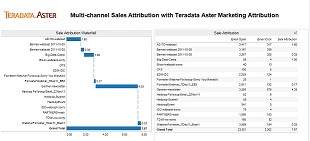Big Data for big marketing


A couple of days ago I had a conversation with Teradata Aster's Stephanie McReynolds. She explained to me how most e-commerce data analysis is based on attributing a sale solely to the first or last click that led to it. Meanwhile, she says, most transactions actually involve between 5 and 10 clicks. And if "multichannel" scenarios (involving, say, a combination of interactions on a new iPad and then in a desktop browser) are analyzed, things get even longer and more complex. Obviously, analysis of all the clicks would be better. Sounds like a job for Big Data, right? Sure. But, again, how can Internet sales pros get hands-on with Big Data technology?
Seems like Teradata's been thinking about this problem and making acquisitions aimed at solving it. The result is Teradata Aster's "Digital Marketing Optimization" solution. DMO seems to integrate all the pieces necessary to make Big Data relevant to the retail strategists and sales managers who really need it.
I think leadership is a part of this. McReynolds' title is Senior Director of Product & Technical Marketing, which seems reasonable enough, but her background is what was especially intriguing to me. McReynolds has done stints at database and business intelligence companies Oracle and Business Objects (now part of SAP), an Enterprise Resource Planning shop (PeopleSoft -- now owned by Oracle) and CRM and marketing-focused E.piphany (now part of Infor). That's a nice pedigree, as it unifies experience with data, back-office and marketing/campaign technology. Seems like the DMO solution that Reynolds represents does likewise.
DMO's back-end is Teradata Aster's database product that combines MPP data warehouse technology, SQL and MapReduce. In the middle tier are the company's Marketing Attribution Module and nPath algorithmic approaches to e-commerce data analysis. Reynolds claims these algorithms eliminate the need for data scientists. (I'm skeptical by default on that, especially since the definition of that profession is still a bit ethereal to me).
For me though, the front-end component of DMO is where a stunning show of common sense enters the solution. DMO's front-end consists of the Integrated Marketing Management applications from Aprimo, which is also a Teradata division. In the end, what's been integrated is the gravitas of a data warehouse vendor that's been around for decades, newer database technology oriented toward MapReduce and some honest-to-goodness business applications.
I've long thought that analytics technology is most powerful when it's embedded in the applications that professionals are using. When you bring data technology to the people who actually need to make data-driven decisions instead of making the people detour over to the technology, you make things more meaningful and actionable. Thankfully, the Business Intelligence world has begun to execute on this over the last few years. It's nice to see that the Big Data players are starting to follow suit.